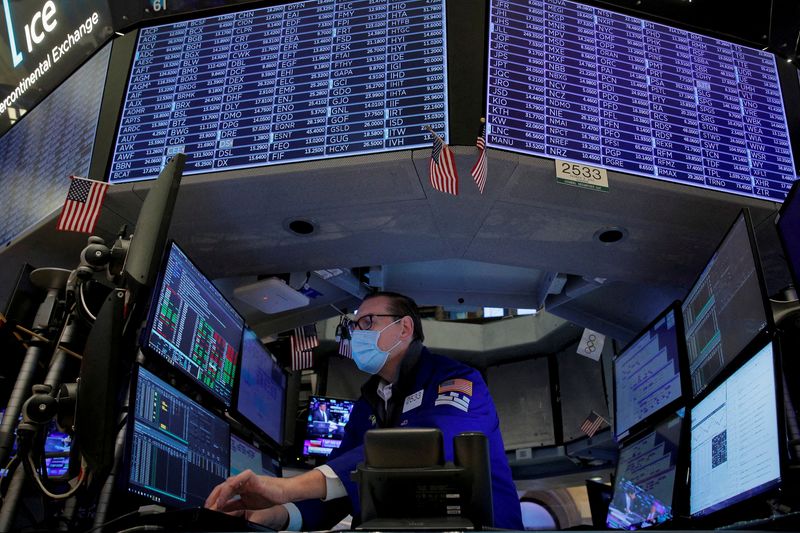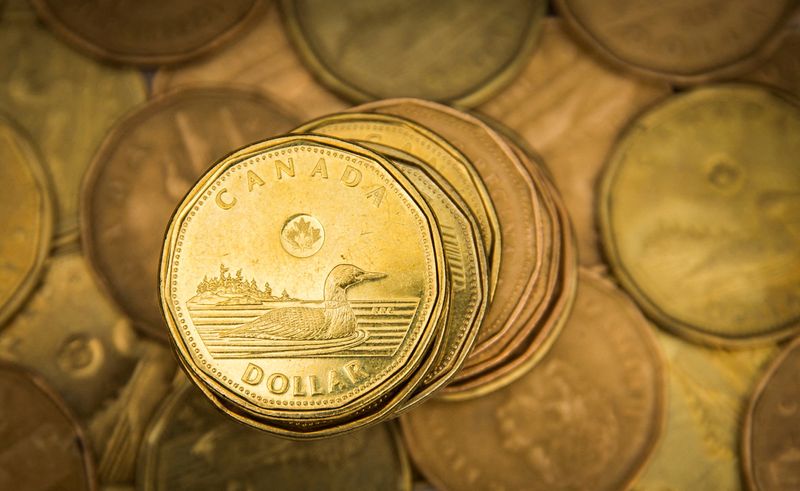
FILE PHOTO: Traders work on the floor of the New York Stock Exchange (NYSE) in New York City, U.S., January 25, 2022. REUTERS/Brendan McDermid
February 17, 2022
By Herbert Lash
NEW YORK (Reuters) – Gold prices jumped to an eight-month high and safe-haven debt rose on Thursday after U.S. President Joe Biden said there was every indication Russia planned to attack Ukraine, while Moscow accused Washington of ignoring its security demands.
A gauge of global equities fell more than 1% despite strong corporate earnings in Europe as the Ukraine standoff deepened. Russian-backed separatists and Ukrainian forces accused each other of firing shells across a cease-fire line and Britain said Russia sought to fabricate a pretext to invade.
Speaking to the United Nations Security Council, U.S. Secretary of State Antony Blinken said Russia was preparing to attack its neighbor in the “coming days.” Russian Deputy Foreign Minister Sergei Vershinin said the comments were regrettable and dangerous.
U.S. and German government bond yields fell and oil slid as talks to resurrect a nuclear deal with Iran entered their final stages, which could unlock more crude supplies. Losses were capped by the tension between top energy exporter Russia and the West.
Investors are already looking toward the long weekend with Monday a U.S. holiday when markets will be closed, Marc Chandler, chief market strategist at Bannockburn Global Forex, said.
“You as a market participant are not incentivized to be fighting the risk-off mood ahead of the weekend when anything can happen,” Chandler said.
The pan-European STOXX 600 index closed down 0.69% while MSCI’s gauge of stocks across the globe shed 1.27%.
On Wall Street, the Dow Jones Industrial Average fell 1.51%, the S&P 500 lost 1.76% and the Nasdaq Composite dropped 2.36%.
Overnight in Asia, MSCI’s broadest index of Asia-Pacific shares eked out a 0.15% rise.
Worries that the Federal Reserve would embark on a super-hawkish interest rate-tightening campaign eased after minutes released on Thursday of its latest policy meeting signaled a measured, even dovish stance by policymakers.
Investors bought government debt. Yields on the U.S. 10-year Treasury note dropped 6.6 basis points to 1.979%, while sliding 0.2 basis points to 0.229% on Germany’s 10-year government bond, the euro zone benchmark, as the Ukraine crisis and weaker-than-expected U.S. data weighed.
The number of Americans filing new claims for jobless benefits unexpectedly rose last week, while freezing weather depressed homebuilding in January.
The Ukraine crisis has unnerved investors who also must watch the Fed and efforts by other central banks to fight soaring global inflation.
“There’s a lot of confusion right now and everybody’s crystal ball is pretty cloudy,” said George Mateyo, chief investment officer at Key Private Bank, speaking of both of Ukraine and how the Fed might tighten monetary policy.
The U.S. economy has weathered COVID-19’s hit on the economy well, with GDP and corporate earnings at peak levels, which bodes well for the market, he said.
“It’s going to be a challenging year, but not a dire year,” Mateyo said. “Expect some volatility this year, but don’t abandon risk altogether, don’t get super defensive. There’s a lot of missed opportunities inside the market.”
Spot gold added 1.7% to $1,899.18 an ounce after briefly breaking through the key $1,900 mark.
Graphic: Gold price- https://fingfx.thomsonreuters.com/gfx/mkt/lbvgnwaekpq/gold%20price.PNG
Oil prices fell more than 2%. U.S. crude futures fell $1.90 to settle at $91.76 a barrel, and Brent settled down $1.84 to $92.97.
The dollar, also considered a safe haven, initially rose against most currencies but gains subsided and it later was marginally lower – suggesting investors were not yet panicking about the Russia-Ukraine tensions.
However the Japanese yen, a currency investors often buy as a safe-haven, hit its strongest since Feb. 7.
The dollar index fell 0.041% as the yen strengthened 0.47% at 114.92 per dollar.
The euro was down 0.09% to $1.1363.
Bitcoin fell 6.78% to $41,096.03.
(Reporting by Herbert Lash, additional reporting by Tommy Wilkes in London, Kevin Buckland and Selena Li in Tokyo; Editing by Kim Coghill, Kirsten Donovan, Barbara Lewis and Andrew Heavens)

